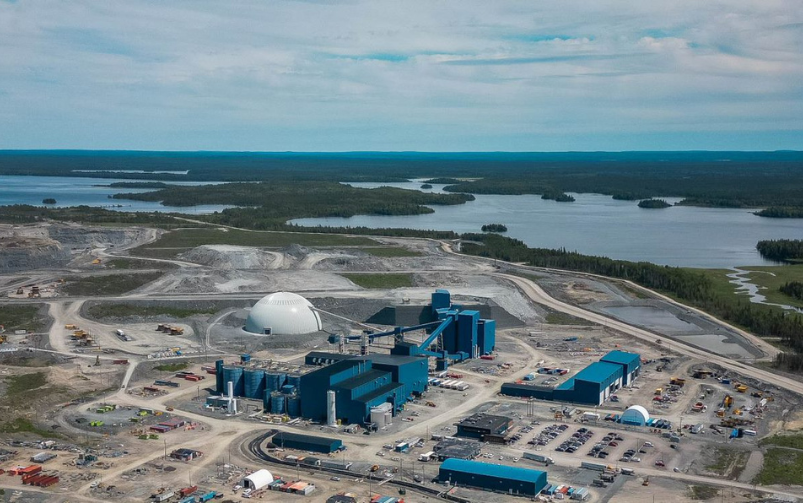Argonaut Gold’s Magino mine, located near Dubreuilville, Ontario, will be acquired by Alamos Gold as part of a friendly takeover following this week’s shareholder approval. Courtesy of Alamos Gold.
Welcome back to your weekly mining news recap, where we catch you up on some of the news you may have missed. This week’s headlines include a raging wildfire near Suncor’s Firebag project, China tightens control over rare earths and a solar plant start up at Diavik.
Rio Tinto plans to build a demonstration plant with carbon-free aluminum smelting cells at its Arvida smelter in Quebec, as reported by Engineering News. The pilot operation serves as a major milestone towards commercializing the ELYSIS technology, which was first trialed at a research and development centre in Saguenay–Lac-St-Jean. The technology is designed to produce aluminum without generating direct greenhouse gas emissions. The $375-million demonstration plant will be jointly owned by Rio Tinto and the Quebec government.
Panama’s new president José Raúl Mulino announced that the country plans to carry out an environmental audit of the idled Cobre Panama mine to assess if it can be safely reopened, as reported by Reuters. The news agency also reported on June 28 that the mine’s owner, First Quantum Minerals, will initiate a formal arbitration proceeding against Panama this month over the forced closure of Cobre Panama at the end of last year.
Argonaut Gold’s shareholders have approved a friendly takeover by Alamos Gold, as reported by Engineering News. In March of this year, the two companies shared that Alamos planned to purchase Argonaut in an all-stock deal priced at US$325 million. A key aspect of the deal involves Alamos’ acquisition of Argonaut’s Magino gold mine, which is located near its own Island Gold mine in Ontario.
With an out-of-control wildfire burning roughly 70 kilometres northeast of Fort McMurray, Suncor Energy has restricted operations at its Firebag oilsands project in northern Alberta as a safety precaution, as reported by The Canadian Press. The fire is also located in proximity to multiple oil sands facilities, including Imperial Oil's Kearl site, whose operations are not currently affected.
The Ministry of Labour, the former Dynatec Corp. and three people have recently been charged with criminal negligence that caused the 2006 death of mechanic Raymond Campeau at the Podolsky mine in Capreol, Ontario, as reported by Northern Ontario Business. Campeau’s wife, Fay Smith, has been seeking to hold the Ministry of Labour and the mine’s owner accountable for Campeau’s death for almost two decades and began pushing for criminal charges in 2016. One of the people charged was a ministry inspector in 2006.
China is introducing numerous measures aimed at increasing control over the country’s valuable rare earth metals, which will take effect on Oct. 1, as reported by Politico. The country has already banned exports of rare earth refining and magnet manufacturing technologies, along with the export of certain gallium and germanium products, and the new regulations will see the Chinese government establish a traceability database to monitor the extraction and use of rare earths.
Rio Tinto has completed a 3.5-megawatt capacity solar power plant at its Diavik diamond mine, located in the Northwest Territories, as reported by Engineering News. The project now stands as the largest off-grid solar power plant in Canada’s North, with the facility expected to produce 4.2 million kilowatt hours of solar energy annually. This will decrease the mine’s diesel consumption by one million litres per year and reduce greenhouse gas emissions by 2,900 tonnes of CO2 equivalent.
Following a dip in annual copper production for the first time in two decades, Chile seems to have turned the corner, increasing output by more than eight per cent as compared to April, reported by Bloomberg. The Chilean government is seeking a five per cent increase in the country’s total copper output this year, bolstered by the expansion at Teck’s Quebrada Blanca mine and updates at BHP’s Escondida mine.
Ailbhe Goodbody mined the CIM archives for the May issue of CIM Magazine to tell the tale of a major merger in B.C.’s Highland Valley porphyry copper district that significantly boosted B.C’s copper output. Following the 1899 discovery of copper in this area, several notable operations, such as the Lornex mine and Highmont mine, were established from the 1960s onwards, though challenges such as increased production costs and low copper prices hindered initial development plans. These issues were resolved in 1986 when Lornex Mining Corporation and Cominco merged their respective assets to form the Highland Valley Copper mine, which positioned the district as a major contributor to B.C.’s copper output; Highmont joined two years later.
The setup of a fully concrete-lined ventilation shaft at Pan American Silver Corporation’s La Colorada mine, located in Zacatecas, Mexico, was completed with notable safety and project success thanks to a collaborative contractual approach to the installation, which saw Pan American and contractor Dumas Mining join forces to jointly develop the contract and project estimate and then work together to resolve any issues, as reported by Alexandra Lopez-Pacheco for the May issue of CIM Magazine. This approach reduced change orders and created a more cohesive project team, prioritizing teamwork over competition.
That’s all for this week. If you’ve got feedback, you can always reach us at editor@cim.org. If you’ve got something to add, why not join the conversation on our Facebook, Twitter, LinkedIn or Instagram pages?




